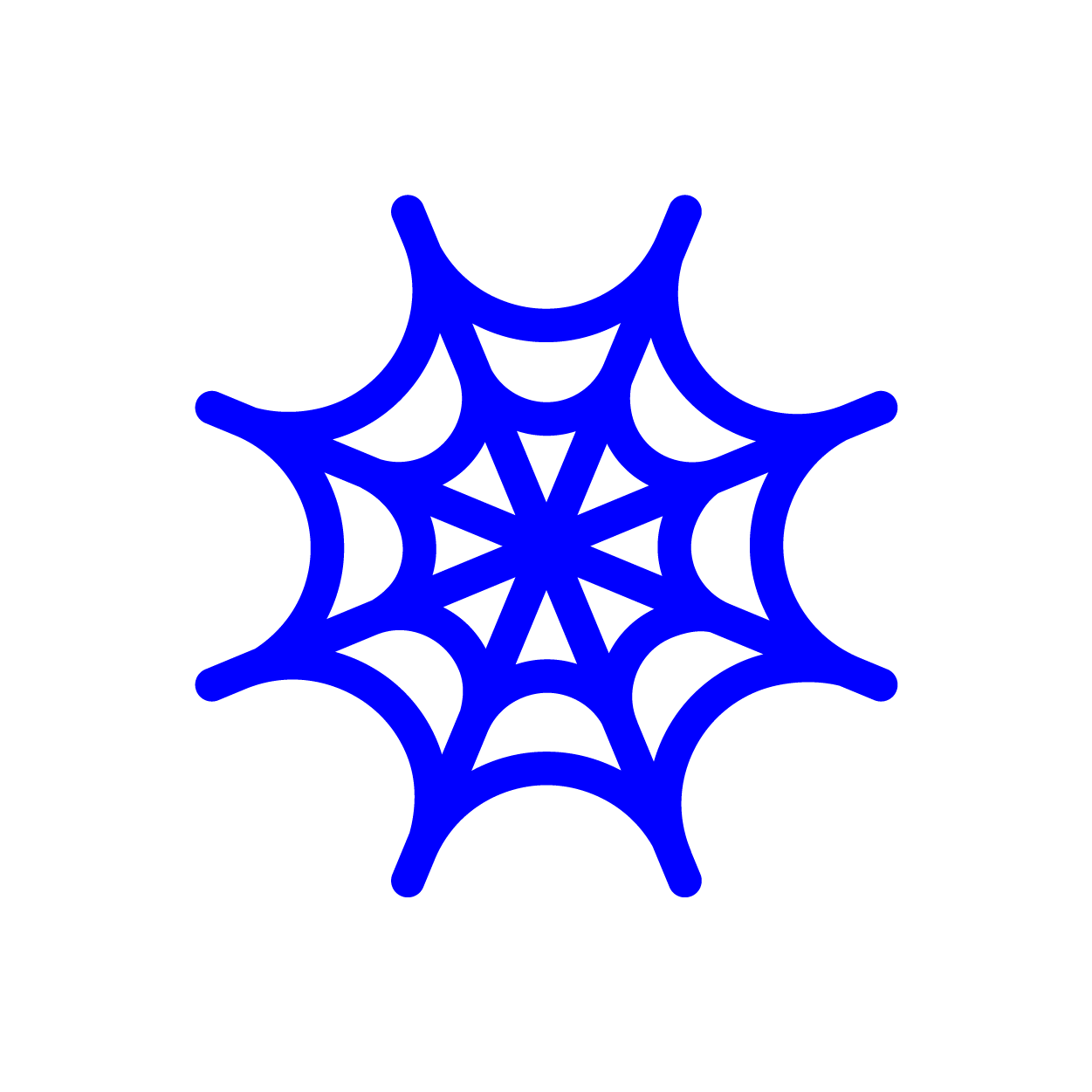bones tan jones
Tunnel Visions
When you’re dancing, you’re putting on a spell on your body, I think. All the protons in the air are energy. If you get someone else to dance with, you can feel this energy connecting you. You can use it as a prayer.
The music I love is the music that might make you cry or feel like your heart is going to burst with love. I hear it as a joyful and powerful spell that shares a frequency with the world. I’ve realized that I use music to craft my own magic.
Trudging through woodland somewhere in southeast England, wafts of petrichor rising from the damp forest floor, you stumble across a clearing. At its center unfurls the gnarled, oaky mass of the Ankerwycke Yew—an ancient tree some 2,500 years old—its trunk like a mutated collage of countless of smaller trees. Allegedly the primary nonhuman witness to the signing of the Magna Carta, this yew has also withstood the invention of countless other human-made systems: capitalism, the privatization of land, and linear-progressive time being three of them. How arbitrary and self-destructive these protocols must seem to such an interstitial being. Putting your ear to its rough-hewn bark, you think you can make out a faint rhythm, almost like a pulse…
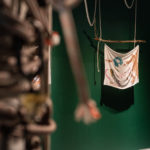
bones tan jones, Tunnel Visions, installation at QUEERCIRCLE, London, 2022. Photo by Deniz Guzel, courtesy of QUEERCIRCLE.
bones tan jones has a metamorphic practice keyed on ideas of deep interconnectivity. Across a mycelial web merging music, performance, painting, video, sculpture, and movement, tan jones nurtures a kind of ecosystemic consciousness. Their works leverage magic and affect, interweaving sound waves and storytelling in order to graft onto a future somewhere beyond the binary of utopia and dystopia.
Projects like The New Elementals (2021), Psychic Excavations (2021), Tectonic Incantations (2020), and Parasites of Pangu (2019) hint at a type of shared ritual between body and environment; a sort of multi-species transformation that melds deep, geologic time with the urgency of the present. Combining sculpture, video, and performance rituals, these works are portals into alternative worlds exploring science-fiction strategies, queer futurism, collaborative myth-making, and ecological storytelling. tan jones’ practice is less a linear trajectory than a spiral; works bleed into each other, putting down roots in unexpected places. Across their work as an artist, musician, herbalist, community organizer, and practitioner of Qigong, tan jones cultivates shared worlds rich in speculative feeling.
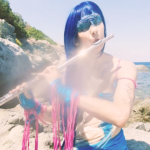
bones tan jones, The New Elementals, video still, 2021. Image courtesy of the artist.
I think physical movement could be a world-building practice in itself. Spending time moving with the Earth. Feeling and embracing the earthen material of our bodies and searching for more ways that we can align our bodies, our music, and our movement with the cycles and tempo of the planet, in a more ecocentric way.
A lot of my work uses this idea of transition and transitioning—something that is visceral, a transition into some kind of way of being. And I am also interested in the transition of this species we call humans to transition into a world that is kind of habitable despite our impact. So when I think about transition and intention, I think about the transition of our species itself.
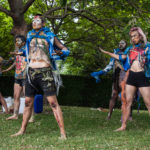
bones tan jones, Parasites of Pangu, performance at Serpentine Galleries, London, 2019. Performed with Monique Etienne, Chantel Foo, Chiyo Gomes and Yodea Williams. Photo by Talie Rose Eigeland.
Sound is perhaps the most collective sense, and music is perhaps the most intentional form of listening. The oldest musical instruments—flutes made of bones and mammoth ivory—date back at least to the Upper Paleolithic period, over 40,000 years ago; the musical use of the voice came much earlier. A new theory in evolutionary history cites the development of music as a precursor to the development of language. In other words, music is a special type of language, a shared tongue of thinking through feeling.
Channeling their musical alter-ego, YaYa Bones, the artist creates vocal spells saturated with shared frequencies of feeling. Borrowing from the innate emotional reciprocity of pop songs—which generate a space of collective feeling that, to continue the prehistorical analogies, is akin to the stories told around an ancient firepit—Bones conjures “protest music for witches, non-binary love songs, and apocalyptic lullabies.” Dreamy and ethereal, yet poppy, goosebump-inducing, and flecked with cosmic dust (the theremin is one of their preferred instruments), the sound is rich in affect. It encapsulates exactly the same energy that defines their art practice (queerness and spirituality, optimism and activism).
“Sitting down and writing music is a form of ritual itself,” suggests tan jones. “Making soundtracks is like writing feelings into the world. It’s magic to have an idea and translate it into sound waves.”
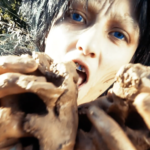
bones tan jones, The New Elementals, video still, 2021. Image courtesy of the artist.
When I wrote the song I was in the mountains alone and I cut off my phone. I felt like the limitations that I had when I was traveling to the mountains was what made the language resonate so much. So it’s not even that magic is language, or identity. It’s the limitations of living.
All of this contemplation – beyond the ideas of utopia, dystopia, the failures of representation – came out of my true love for pop music and what it does for me. My favourite pop stars are so far removed from being human: they’re like aliens with access to some other-worldly communion and feeling that not many are able to grasp; yet everyone can relate to.
Community and collaboration are two cornerstones of tan jones’ practice, but the artist also understands the significance of a solo pilgrimage. Last summer, tan jones embarked on a six-day walking voyage to Stonehenge, calibrating their arrival to the sacred site with the summer solstice. At the heart of the journey was a deeper understanding of the complex interplay of ecological and human-engineered systems that define contemporary Britain. On their journey, tan jones discovered a dizzying kaleidoscope wherein power lines overlaid historically significant ley lines and gas pipelines eviscerated ancient burial mounds. This experience culminated in Tunnel Visions, an exhibition at Queercircle’s new permanent space in Greenwich, south London.
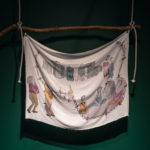
bones tan jones, Tunnel Visions, installation at QUEERCIRCLE, London, 2022. Photo by Deniz Guzel, courtesy of QUEERCIRCLE.
During their pilgrimage, tan jones experienced both incredible highs and lows. They were elevated by love songs from their community that lifted their spirits in periods of extreme exhaustion; they also experienced firsthand the toxic effects of rampant privatization of the land and evermore industrial development, including the tunnels under Greenwich and Stone Henge. These tunnels, under construction and in planning respectively, are among the most recent environmental controversies within the UK that threaten to foreclose a shared, sustainable future for the country’s human and nonhuman residents alike. But by holding together these moments of darkness and light, tan jones discovered, it becomes possible to open that window back up together.
“When you’re at a gig or festival and you’re listening to an artist who is creating this huge frequency, there’s a connection everybody has – even if they’re all feeling different things at the same time,” explains tan jones. “During my time at Stonehenge, I realized the same thing: it’s a ritual for honoring the ancient land and sacred points of energy, and also a resistance against privatization and restriction of access to this land.”
In the opera project Parasites of Pangu (2019) and the film work The New Elementals (2021), tan jones reinvents an ancient Chinese creation myth inside a speculative post-apocalypse. Merging reality TV show aesthetics with a queer POC-led pop idol boot camp, the work reveals the hyper-construction of all narratives, including linear time, clearing the path to an alternative vision for the future.
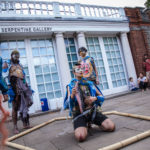
bones tan jones, Parasites of Pangu, performance at Serpentine Galleries, London, 2019. Performed with Monique Etienne, Chantel Foo, Chiyo Gomes and Yodea Williams. Photo by Talie Rose Eigeland.
The narrative of both works follows four parasites or ‘elements’ of the apocalypse—Flame of Perpetual Darkness, Swamp Witch, print of the Underground, and Last Breath—as well as the artist, who appears as a psychic archaeologist unearthing artifacts from the future. The group returns to a wrecked home planet as its caretakers, selected from the aforementioned pop boot camp. Queer narrative tactics abound, from the inversion of the storyline across the later work, The New Elementals, which serves as a prequel unpacking the earlier opera project.
The works also reclaim Pangu, a Chinese mythological figure whose collapsed body forms the Earth, Sun, and Moon, and who is historically represented as a male persona, as a nonbinary deity. The narrative also speculates on ancestral wisdom—knowledge that is passed through the body across generations and resists linear time. Like much of tan jones’ practice, these projects lean into a space of uncertainty, finding a shared home in the generative potential of myth-making.
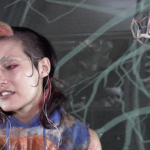
bones tan jones, The New Elementals, video still, 2021. Image courtesy of the artist.
In Parasites of Pangu, I was trying to identify with them, thinking about what their ultimate fantasy would be. It isn’t necessarily an illusion that we have of them, because they can have it too! So this piece was about the blurring of reality and fantasy and imagining myself into the fantasy itself. What I wanted most in creating this piece was having such a feeling come through to the audience—to communicate a sense of community, love, supportiveness, and understanding.
tan jones describes the collaborative creative process behind Parasites of Pangu as an exercise in mycelial thinking—by building worlds centered around queer POC, they elevate the spaces where they feel safest, most joyful, and deeply interconnected. Parasites of Pangu and The New Elementals also forge a link between the body and environment—which is, itself, a body. Merging plant magic with queer futurism, the works reveal a sort of ecosystemic consciousness—where the body of the planet and the bodies of its caretakers meld into one—a queering of the Pangu creation myth that underscores the interconnectedness of the Earth’s future and our own.
“We’re never not part of nature,” they suggest. “The idea that nature and human are separate things is a construct – a construct that has emboldened us to cause so much damage to the planet. So reconnecting back to nature through movement and through feeling at one with it all is really useful.”
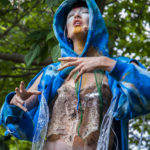
bones tan jones, Parasites of Pangu, performance at Serpentine Galleries, London, 2019. Performed with Monique Etienne, Chantel Foo, Chiyo Gomes and Yodea Williams. Photo by Talie Rose Eigeland.
Movement for me is basically about embodying the earth. And about how you move on the earth, and how the earth moves beneath you. I like to look at the ocean for example, looking at the water moving back and forth and how the waves move up and down. If you dance or move from your gut, you actually act like you’re the ocean: you’re a part of this elemental force that moves. And if you can do that, you realize you can’t oppress anything. Because when you move like that, you’re just a part of the universe. You can’t harm anything. You can’t be anything but yourself. All your movements come from love.
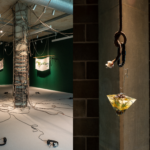
bones tan jones, Tunnel Visions, installation at QUEERCIRCLE, London, 2022. Photo by Deniz Guzel, courtesy of QUEERCIRCLE.
For the last few years, tan jones has been a student of Qigong, a traditional Chinese healing practice that they refer to as a type of movement medicine. This conscious, embodied practice aims to open up certain meridians or activate specific pressure points through thousands of different forms, many of which are derived from natural movements, including the frolicking of animals or the movement of water.
Mirroring the movement of the world through daily Qigong practice, alongside the subconscious activation of and deep listening to their dream states, are two fundamental components of the artist’s practice. To look across tan jones’ multidimensional practice is to bear witness to a mystical feedback loop—like the cosmic theremin, or a trained neural net—that’s always evolving and learning from itself through its relationship to the world.
![]()
On the full moon I dream of this future that’s like a landfill. Building the future in my dream is like cleaning up all the mess. What’s the difference between escapism and futurism? What I mean by escapism is a false notion of the future. For me escapism and sci-fi are closely related. You know, sci-fi tells us an idea of what the future looks like, but it doesn’t account for an alternative future.
This futurist balance, like yin and yang, creates a scaffolding for what tan jones calls a “queer, alternative, optimystic dystopia”. Rejecting the false binary of utopia and dystopia, this third way presents an alternative view of the world and its multiple possible futures. Here, the better parts of a dystopian future can be salvaged and reimagined together, in queer solidarity. For tan jones, it’s important to cultivate these worlds in tangible ways—as seen through Shadow Sistxrs Fight Club, a community self-defense and herbalism class for women, QTIPoC, and nonbinary folks co-founded by the artist in 2017. Brought to life collectively, their projects seed the vision of a queer speculative future, nurtured tenderly from the compost heap of this heating planet.
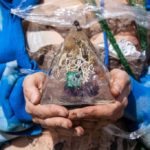
bones tan jones, Parasites of Pangu, performance at Serpentine Galleries, London, 2019. Performed with Monique Etienne, Chantel Foo, Chiyo Gomes and Yodea Williams. Photo by Talie Rose Eigeland.
Futurism involves seeing the present as fragmented and fractured, but it’s also understanding that in this place of disruption, there’s the opportunity to build something else. I don’t care if the future looks like total annihilation. It can be a utopia if it means that our communities are living in solidarity above us.


